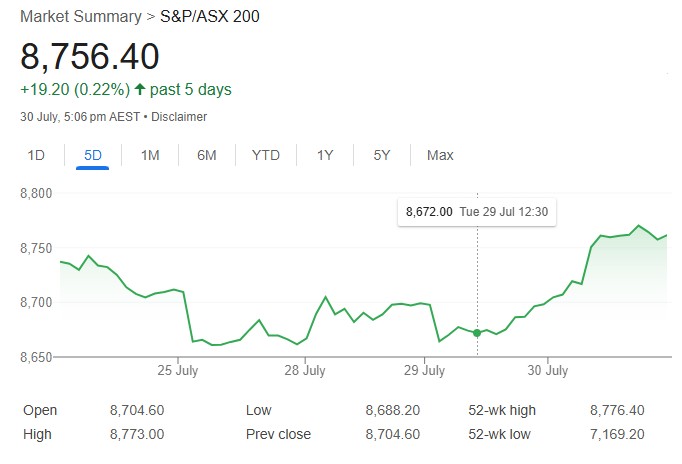| Name | Price | Change | % Chg |
|---|---|---|---|
| Dow | 44,461.28 | -171.71 | -0.38% |
| S&P 500 | 6,362.90 | -7.96 | -0.12% |
| Nasdaq | 21,129.67 | 31.38 | 0.15% |
| VIX | 15.48 | -0.5 | -3.13% |
| Gold | 3,333.10 | -19.7 | -0.59% |
| Oil | 70.36 | 0.36 | 0.51% |
OVERVIEW OF THE US MARKET
The S&P 500 fell 0.1% and Treasury 10-year yields rose around five basis points Wednesday. While the concerted pullback in stocks and bonds looked mild, it marked the worst Fed Day since December. The dollar strengthened 0.8% as Fed Chair Jerome Powell said no decision had been made about easing policy in September. The US labor market “looks solid,” he said, while inflation remains above target.
The Dow Jones Industrial Average gave up 0.4%, the S&P 500 slipped 0.1%, while the tech-heavy Nasdaq composite eked out a 0.1% gain. Declines were broad-based, with eight out of the 11 S&P 500 sectors ending the day in the red.
Data released Wednesday showed gross domestic product increased an annualized 3% in the second quarter after shrinking at a 0.5% rate in the previous period. The swing was caused largely by the front-loading of imports in the first quarter as companies moved to get ahead of tariffs. Consumer spending advanced at its slowest pace over consecutive quarters since the onset of the pandemic.
Inflation came in below estimates for a fifth straight month in June, though prices of some goods directly exposed to tariffs — including toys, apparel and electronics — jumped. Unemployment ticked lower to 4.1%, as the administration’s crackdown on immigration reduced labor supply.
Separately, President Donald Trump said he reached a trade deal with South Korea that would impose a 15% tariff on its exports to the US and see Seoul agree to $350 billion in US investments. Copper sank as Trump exempted the most widely imported form of the metal from his planned tariffs.
Trump also said he would impose a 25% tariff on India’s exports to the US starting Friday and threatened an additional penalty over the country’s energy purchases from Russia. The rupee declined in offshore trading while contracts for the Nifty 50 erased their gains to decline as much as 0.5%.
Microsoft (MSFT): Shares rose 7% after the technology titan reported a strong quarter, driven by cloud services and AI demand.
Meta Platforms (META): The social-media giant’s shares jumped 9% after it posted revenue growth that underscored strength in its core ad business.
Shares of UPS and FedEx slid Wednesday after the White House said that the U.S. would end the de minimis rule that has allowed packages worth $800 or less to be imported duty-free. It had already halted the practice for Chinese goods in May.
OVERVIEW OF THE AUSTRALIAN MARKET

The Australian equity market surged on July 30, 2025, driven by better-than-expected inflation data that bolstered expectations for Reserve Bank of Australia (RBA) rate cuts. The S&P/ASX 200 (XJO) climbed 51.8 points to close at 8,756.4, a 0.60% gain, recovering from a session low and finishing just 0.19% shy of its high. The broader S&P/ASX 300 (XKO) saw advancers outpace decliners by 177 to 105, reflecting broad-based optimism.
Australia’s CPI slowed to +2.1% YoY in July, below expectations of +2.2% and down from +2.4% previously. Quarterly inflation eased to +0.7% QoQ, reflecting broad-based moderation. Services inflation fell to a three-year low of 3.3%, driven by slower rises in insurance and rent. Goods inflation dropped to 1.1%, helped by a -10% fall in fuel prices and softer housing costs. Price growth also eased across food, alcohol, clothing, insurance, and education. Transport costs declined further, while inflation remained steady in housing, health, and recreation. The trimmed mean CPI fell to +2.7% YoY, its lowest since Q4 2021, positioning the RBA for a potential rate cut. AMP Economist My Bui noted that this “likely met the RBA’s criteria for a rate cut,” forecasting four cuts by Q2 2026, potentially lowering the cash rate to 2.85%.
Consumer stocks led the charge, with defensive names like Coles (COL, +1.7%) and Woolworths (WOW, +1.6%) gaining alongside discretionary plays such as Collins Food (CKF, +2.0%) and Breville (BRG, +1.7%). Interest rate-sensitive sectors also shone, with Real Estate Investment Trusts (XPJ, +1.3%) and Financials (XFJ, +1.1%) capitalizing on the prospect of lower rates. Standout performers included AMP (AMP, +0.9%, +27.8% over 1 month) and Pro Medicus (PME, +0.9%, +138.7% over 1 year).
However, weaker base metals and iron ore prices weighed on Resources (XJR, -0.25%), with companies like Pilbara Minerals (PLS, -1.5%) under pressure. Information Technology (XIJ, -0.4%) also lagged, reflecting a pullback in US tech stocks. Notable losers included Flight Centre Travel Group (FLT, -3.6%) and Treasury Wine Estates (TWE, -2.9%).
Global trade developments added context, with US-China trade talks in Stockholm concluding productively but without major breakthroughs. Reports of potential 20-25% US tariffs on India and a narrowing US goods trade deficit underscored ongoing trade tensions, which could impact Australian exporters if escalated.

